We were delighted to sponsor ‘Building of the Year’ for the RIBA Regional Awards in 2024.
Congratulations to all that were shortlisted and of course the winners!
Date posted: 2 June 2024
RIBA Regional Awards 2024
We were delighted to sponsor ‘Building of the Year’ for the RIBA Regional Awards in 2024.
Congratulations to all that were shortlisted and of course the winners!
Date posted: 2 June 2024
Description
The Award winners for “Building of the Year” in each region were:

The Elizabeth Line is a tour de force. Running across London from Heathrow Airport and Reading at the west to Shenfield and Abbey Wood in the east, it boasts 62 miles of track, 26 miles of new tunnels, 10 new and 31 upgraded stations including some 9 to 10 storeys below ground, and is anticipated to carry 200 million passengers per year.
Its success is the outcome of intense collaboration between the multidisciplinary team of architects, engineers, lighting designers, and wayfinding experts, as well as manufacturers and suppliers. The aim was to provide users with as coherent an experience as possible, create a familiar feel, improve comfort for cross-London travel, ease navigation and flow, and standardise elements. The design adopts a clear visual language and has a consistent material palette and approach to detailing.
Working across the Elizabeth line the line-wide design team of Grimshaw, Maynard, AtkinsRéalis and Equation was part of a wider Crossrail architectural design team, interfacing with architects across the line’s 10 new stations including John McAslan + Partners, Weston Williamson + Partners, Hawkins\Brown, Aedas, Wilkinson Eyre, BDP, Adamson Associates, Allies and Morrison and Fereday Pollard.
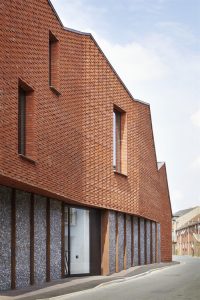 This transformative project has seen a significant regional and national museum emerge from the adaptation of what was previously a small, local resource. The focus of the museum is the historic home of 18th century artist Thomas Gainsborough in Sudbury, Suffolk. Not only has the project conserved this Grade I listed house, but it has also provided exhibition galleries and supporting facilities through a combination of adjacent historical buildings and new structures.
This transformative project has seen a significant regional and national museum emerge from the adaptation of what was previously a small, local resource. The focus of the museum is the historic home of 18th century artist Thomas Gainsborough in Sudbury, Suffolk. Not only has the project conserved this Grade I listed house, but it has also provided exhibition galleries and supporting facilities through a combination of adjacent historical buildings and new structures.
Together, the modifications have allowed the museum to double its visitor numbers, increase its community engagement, and secure its future within the precarious climate faced by arts institutions in the post-Covid world. All this has been achieved with great ingenuity and a sensitivity to detail and materials selection, which is all the more remarkable given the relatively constrained budget for such an extensive and complex programme.
 Hay Castle sits in the heart of the Powys market town of Hay-on-Wye. Having been in private ownership for the best part of 900 years, this project has adapted the castle and its grounds into a unique historic destination for many to visit and enjoy.
Hay Castle sits in the heart of the Powys market town of Hay-on-Wye. Having been in private ownership for the best part of 900 years, this project has adapted the castle and its grounds into a unique historic destination for many to visit and enjoy.
It involved a major conservation-led renovation and repair of the important historic building, which included contemporary interventions to bring the castle back to life and for public benefit. It has not only delivered a vibrant place for gathering, learning, and the arts but also made important connections between castle and town to reinvigorate its location and offer views across the River Wye and the valley beyond.
This is a fine example of a thoroughly researched and applied set of works in conservation and heritage for contemporary use. MICA Architects have shown all their skills in achieving such quality architecture to the benefit of many.
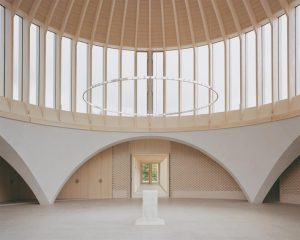 Perfectionists should start the pilgrimage to rural Hampshire now, as the architecture of this new temple for a non-denominational multi-faith spiritual organisation is so exacting it literally calms the mind – until you start thinking about how it was achieved.
Perfectionists should start the pilgrimage to rural Hampshire now, as the architecture of this new temple for a non-denominational multi-faith spiritual organisation is so exacting it literally calms the mind – until you start thinking about how it was achieved.
Positioned on a spur of hillside, along an ancient ley line, the whitewashed timber-framed building with chalk-coloured brick sits monumentally in the landscape. A series of chakra gardens draws people towards the main temple – although you can enter from any side, a point that emphasises how all four corners of the world are welcome. If you can resist the draw of the domed temple, you can postpone enlightenment through an arrival sequence that leads from secular to ritual spaces.
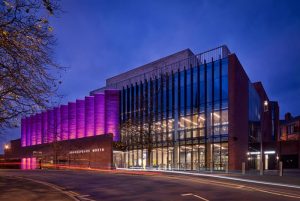 Shakespeare North is a new theatre building focused on promoting learning, experimentation, and reinterpretation of the works of Shakespeare. Prescot is thought to have been the only English town outside of London to have had a freestanding, purpose-built indoor playhouse in the Elizabethan and Jacobean eras. Shakespeare is believed to have belonged to a troupe of actors who performed there. This backstory has led to a historically accurate re-creation of an Elizabethan theatre as the building’s kernel.
Shakespeare North is a new theatre building focused on promoting learning, experimentation, and reinterpretation of the works of Shakespeare. Prescot is thought to have been the only English town outside of London to have had a freestanding, purpose-built indoor playhouse in the Elizabethan and Jacobean eras. Shakespeare is believed to have belonged to a troupe of actors who performed there. This backstory has led to a historically accurate re-creation of an Elizabethan theatre as the building’s kernel.
Around it, the architect has set a contemporary wrapping in the form of a concertina ‘screen’ of brick and glass, containing the foyer and bar areas to the front of house and rehearsal and admin spaces to the rear. The project aimed to inspire a community, transform opportunity, raise educational aspiration and attainment, and play a part in regenerating one of the most deprived boroughs in the UK.
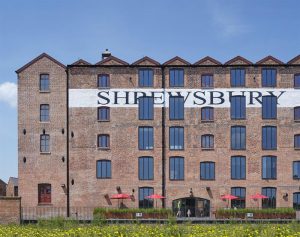 The brief for this project called for an exemplar of sustainable refurbishment to support the next 100 years of use for a building with a particularly innovative design heritage.
The brief for this project called for an exemplar of sustainable refurbishment to support the next 100 years of use for a building with a particularly innovative design heritage.
Opened as a flaxmill in 1797, it was the world’s first iron-frame building and has been described as the ‘grandparent of skyscrapers’. Its combination of cast iron beams and columns, brick arches, and cast iron ties made its construction fireproof, while large windows admitted natural light for its numerous employees. A century later, it was converted into a maltings through a second state-of-the-art design, with windows either blocked up or made smaller, boiler houses demolished, a timber hoist and new tower added, and a large kiln built.
Feilden Clegg Bradley Studios have conserved the enduring elements of both uses to provide four floors of flexible working space, while cleverly weaving in a contemporary layer to accommodate a visitor centre and café.
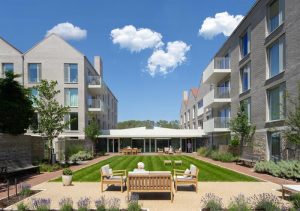 This scheme with apartments for sale and rent for the over 65s has replaced a derelict office building in the leafy Surrey village of Cobham. The enlightened client recognises that exemplary design is important to an increasing number among Britain’s ageing population, and wants to offer well-designed, sophisticated options for those wishing to downsize or move into accommodation more suitable for later living.
This scheme with apartments for sale and rent for the over 65s has replaced a derelict office building in the leafy Surrey village of Cobham. The enlightened client recognises that exemplary design is important to an increasing number among Britain’s ageing population, and wants to offer well-designed, sophisticated options for those wishing to downsize or move into accommodation more suitable for later living.
Cobham Bowers provides quality accommodation for individuals and couples transitioning from long-term family homes to a more compact and convivial way of life. The architects have arranged its 53 light-filled flats, with generous balconies and windows, in two light grey brick buildings linked by a communal ground-floor space and a peaceful lush walled garden. Each of the blocks is divided by six expressive pitched roofs oriented in different directions, to break up the mass and attune with other village buildings.
 Commissioned and built by the local council, this stunning new building on Bournemouth beach puts its money where its mouth is on every front. Its purpose is to affect a step change in behaviour by making the public more aware of what they are throwing away, and to build a sense of environmental guardianship of the coastline. At its core is a two-storey, highly insulated, Passivhaus certified education centre and welfare block for the beach cleaning team.
Commissioned and built by the local council, this stunning new building on Bournemouth beach puts its money where its mouth is on every front. Its purpose is to affect a step change in behaviour by making the public more aware of what they are throwing away, and to build a sense of environmental guardianship of the coastline. At its core is a two-storey, highly insulated, Passivhaus certified education centre and welfare block for the beach cleaning team.
An array of solar panels on the roof more than offsets energy consumed, making the Hub carbon positive. On one side is a service yard, and on the other a green roof shelters an outdoor education, exhibition and café terrace. The architects ensured that reuse and recycling were central to the project, and any new materials were rigorously examined to select those with the lowest embodied carbon.
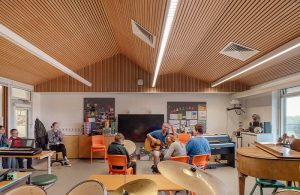 On first arrival at this school on the outskirts of Alfreton in Derbyshire, it is evident that it has been carefully crafted, both internally and externally, to address the children’s and teachers’ needs. The architects have responded to the brief with both playfulness and architectural quality while meeting the stringent technical requirements of the county council client and the building’s users.
On first arrival at this school on the outskirts of Alfreton in Derbyshire, it is evident that it has been carefully crafted, both internally and externally, to address the children’s and teachers’ needs. The architects have responded to the brief with both playfulness and architectural quality while meeting the stringent technical requirements of the county council client and the building’s users.
Comprising four loosely arranged buildings nestled against the brow of the hill, the informal plan belies an exceptionally well thought through hierarchy of spaces. Two teaching wings have classrooms facing the open countryside and ancillary breakout and specialist rooms on the northern side. The main communal hall sits on the more public side of the school, opening out onto a semi-enclosed courtyard, and its overhanging roof provides shelter to children arriving to start their day. Completing the arrangement is a discreet reception and staff building.
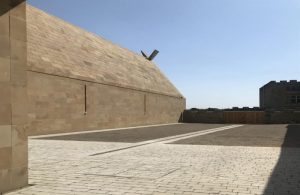 Auckland Castle is a Grade I listed medieval episcopal palace which has been the seat of the Bishop of Durham for nearly a millennium. Sitting to the north of Bishop Auckland, it is nestled between the rivers Wear and Gaunless. Since acquiring the site in 2012, the Auckland Project has been transforming it into a centre for arts, culture, and heritage, for locals and visitors.
Auckland Castle is a Grade I listed medieval episcopal palace which has been the seat of the Bishop of Durham for nearly a millennium. Sitting to the north of Bishop Auckland, it is nestled between the rivers Wear and Gaunless. Since acquiring the site in 2012, the Auckland Project has been transforming it into a centre for arts, culture, and heritage, for locals and visitors.
As part of the transformation, a collection of elements with differing forms and uses has been delivered. The Auckland Tower and Faith Museum, both by Níall McLaughlin Architects, are welcome new additions. The tower acts as a beacon for the town and gateway to the castle grounds, while the Faith Museum with its compelling barn-like form provides space for exhibition displays on faith in Britain. Painstaking conservation works to Auckland Castle by Purcell help safeguard its historic fabric for future generations.